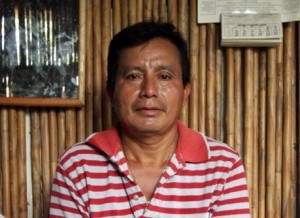A Canadian mining watchdog group is warning that Hudbay Mineral Resources, the Toronto-based company seeking to gain control of the Rosemont copper project, has “a profound disrespect for the environments and communities where it operates.”
MiningWatch Canada program coordinator Ramsey Hart says that U.S. regulatory agencies, local Arizona governments and the general public should not be “lulled into a false sense of security” by Hudbay’s corporate communications that emphasize the company’s environmental stewardship and commitment to human rights.

A pond at Hudbay’s abandoned Spruce Point mine appears devoid of life. Photo by Eric Reder, Manitoba Wilderness Committee
Hudbay, Ramsey states, is currently being sued for negligence in Canadian courts in connection with violent crimes at its former nickel project in eastern Guatemala, including the murder of an Indigenous Mayan land rights activist by mine security guards.
Hudbay has also failed to adequately consult Indigenous communities about mining operations, operated a heavily polluting copper smelter that was the largest single source of mercury and other toxic emissions in Canada until it closed in 2010; and failed to adequately rehabilitate closed mine sites, Ramsey states.
The proposed Rosemont copper project is currently owned by Vancouver, B.C.-based Augusta Resource Corporation. Augusta’s board of directors has agreed to accept Hudbay’s offer to purchase the company. The stock and warrants deal, worth an estimated $516 million, is expected to close later this month.
The proposed Rosemont mine is located in the Santa Rita Mountains on the Coronado National Forest southwest of Tucson. The $1.2 billion open pit mine would be the third largest copper mine in the United States.
In a briefing paper attached to its July 10 press release, MiningWatch provided an overview of Hudbay’s alleged human rights abuses in Guatemala and serious environmental issues in northern Manitoba.
In 2008, Hudbay merged with Skye Resources, whose primary asset was the Fenix Project in eastern Guatemala. In 2009, Adolfo Ich Chamán, a respected indigenous Mayan Q’eqchi’ community leader and an outspoken critic of the Fenix project, was hacked and shot to death by security personnel employed by Hudbay’s subsidiary.
The same day, German Chub was brutally shot in an unprovoked attack also by company security personnel. As a result, German was left a paraplegic and lost the use of his right lung.
Civil suits related to the shootings, along with the gang rape of 11 women during Skye Resources tenure in the area, are before the Canadian courts. One of these women spoke about these crimes.
Hudbay denies responsibility for these occurrences largely on the basis that their Guatemalan subsidiary was managing the site. Hudbay sold its interest in the project to a Russian company in 2011, shortly after the lawsuits were filed.
In northern Manitoba, Hudbay operated an antiquated copper smelter in the small town of Flin Flon. The smelter, which was closed in 2010 after 80 years of operation, was Canada’s largest point source of toxic emissions such as lead, arsenic, cadmium and mercury, and of acid-rain causing sulphur dioxide.
The Toronto Globe and Mail reported that the smelter shut down in part due to HudBay’s unwillingness to invest in greater environmental controls. Minerals mined in Manitoba are now exported for refining.

A NASA photograph tracked pollution from Hudbay’s smelter. The clouds with small droplets in the image at far left, indicated by yellow, were seeded by the aerosols from the copper smelter.
http://earthobservatory.nasa.gov/Features/Pollution/pollution_3.php
A 2007 news report noted that a local nursery school had to keep children inside to avoid pollution from the smelter and that soils in the community had extensive and significant contamination. Fish in the lakes surrounding Flin Flon are reported to have elevated levels of mercury, although the company denies any link to toxic releases from the smelter, MiningWatch states.
Hudbay and its predecessors also owned and operated the small Spruce Point Mine, which is inside Grass River Provincial Park east of Flin Flon. The mine operated for six years and ceased production in 1988.
The Wilderness Committee of Manitoba conducted a field investigation of the site and discovered a variety of wastes left behind including areas of unreclaimed mine tailings and a pond contaminated with extremely high levels of cadmium, aluminum and copper. Hudbay sold the unremediated mine site in 2011.
Despite considerable public opposition to mining in provincial parks, Hudbay has begun operations at another mining project also within Grass River Provincial Park – the Reed Lake Mine. According Hudbay’ 2013 annual report, the Reed Lake Mine is expected to add approximately 15,000 tons of annual copper production over a five-year mine life.
The Reed Lake Mine, Mining Watch states, has outraged environmental organizations and First Nations communities. Representatives of the Mathias Colomb Cree Nation (MCCN), the Assembly of Manitoba Chiefs, the Manitoba Keewatinowi Okimakanak and the Manitoba Wilderness Committee pledged to oppose the mine because it is being built and operated within the traditional territory of the MCCN without its permission.
HudBay’s Lalor Lake project is also coming under fire from the MCCN. Hudbay’s 2013 Annual Report states the Lalor zinc, gold and copper deposit is on track to become the company’s next major underground mine. First ore was produced in 2012 through the ventilation shaft, and production from the main shaft is expected in the second half of 2014.
Hudbay states it is refurbishing its Snow Lake concentrator located east of Flin Flon and doubling its capacity to handle the increased production from the Lalor mine.
The MCCN issued two stop work orders and an eviction notice to Hudbay in 2013 due to its lack of respect for First Nation rights and failure to obtain its consent for the Lalor mine project. A Manitoba court, however, granted Hudbay’s request for an injunction to prevent the MCCN from protesting at the mine site.
In May 2014 the Manitoba Metis Federation issued a statement indicating grave concern over the lack of adequate reclamation at Hudbay’s closed Ruttan Lake operation in the town of Leaf Rapids, Saskatchewan northwest of Flin Flon. The Federation stated a legacy of poor planning and incomplete site remediation by Hudbay is creating serious threats to the health of downstream lakes and streams.


4 Responses to Hudbay has ugly environmental and human rights track record, warns a Canadian mining watchdog group